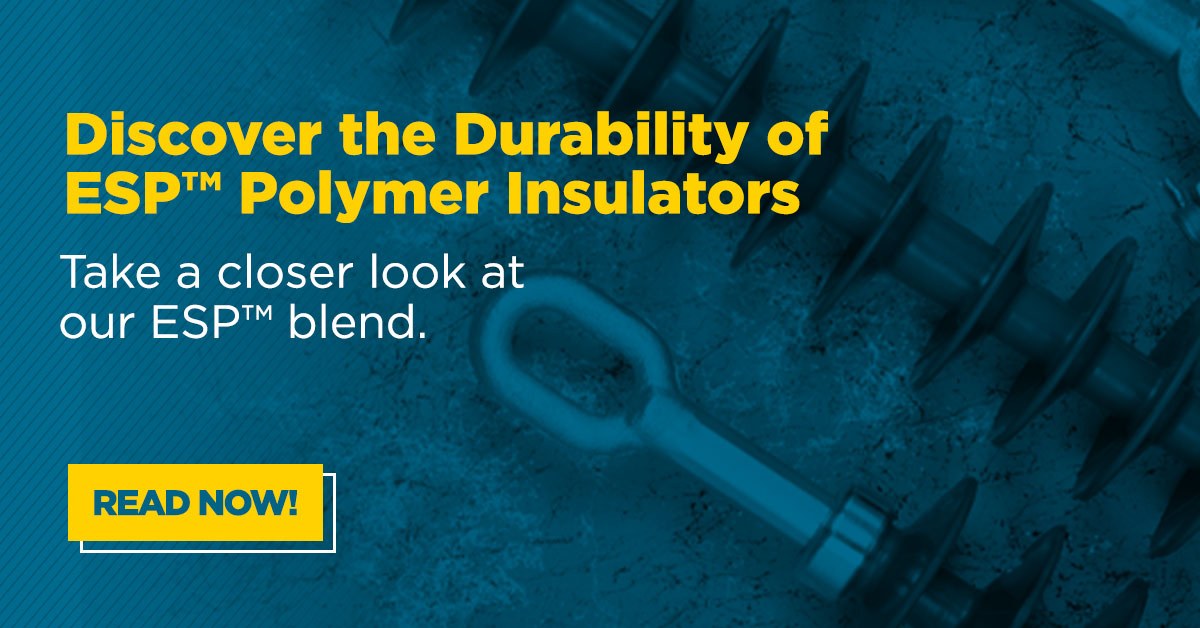Polymer compounds for insulator housings are integral to the life of insulators. Previously, we discussed types of polymers, their compounding, and testing. Let’s look closer at Hubbell’s ESP™ enhanced silicone polymer. This proprietary blend results from decades of polymer research. ESP polymer is a reliable material for high voltage insulators.
The right mix adds up to better performance
Although most polymers are labeled by their base polymer, many additional ingredients are combined to deliver the desired properties. The performance of the material is defined by the compounding of ingredients, the process, and the manufacturer’s design for the final polymer insulator. Hubbell’s development of polymer materials suitable for high voltage applications evolved into the ESP blend of ethylene propylene diene monomer (EPDM) and silicone.
Discover superior performance in our white paper “Hubbell’s Proprietary ESP enhanced silicone polymer explained.”
Compounding an elastomer with fillers and additives is critical to achieve the desired results for a given application. Compounds suitable for electrical insulation consist of 3 categories of ingredients. These include the base polymer, fillers, and additives.
Selection of the base polymer, called an elastomer, is the first step in designing a reliable compound for electrical applications. ESP polymer uses a combination of EPDM and silicone to form the base that makes up about 40% of the total compound.
Fillers are classified as reinforcing and extending. Reinforcing fillers improve tensile strength, modulus, tear strength and abrasion resistance of a compound. Extending fillers enhance desirable electrical properties characteristics and flammability resistance. Alumina Trihydrate (ATH, or Hydrated Alumina) acts as an extending filler in ESP polymer, further improving the compound’s already good electrical characteristics.
Additives also define a polymer’s properties. They support the manufacturing processes by protecting the chemical bond between fillers and elastomer during vulcanization. The unique combination of these is integral to tailor the polymer to expected electrical and mechanical stresses in the field.
The characteristics of high performance
Base materials, fillers, and additives determine the compound’s ability to withstand the degrading influences a polymer insulator experiences in the field. Several distinct characteristics contribute to the long-term performance of polymer insulator housings in high voltage service, including:
- Resistance to tracking and erosion
- Ultraviolet (UV) resistance
- High mechanical strength
- Hydrophobicity
- Low flammability
The ability to resist tracking and erosion, especially under contaminated conditions, is an important characteristic. ESP polymer does not track. The EPDM base, when exposed to high temperatures, reverts to a gaseous state, leaving no conductive residue. This key property serves to prolong the service life of the polymer, regardless of the level of hydrophobicity.
In the field, polymer material is exposed to UV from either sunlight, corona, or dry band arcing, which can cause changes to the surface of the polymer. In the case of ESP polymer, a light chalking develops during this process as a reaction to exposure to UV. It serves to protect the underlying substrate from severe UV damage. ESP polymer effectively withstands the damaging effects of this type of exposure in the field.
High mechanical strength describes the ability to resist abrasion and tearing. Physical damage to insulator housings can compromise the effective seal and protection of the fiberglass rod, leading to moisture ingress and ultimately insulator failure. Improper handling during transportation or installation can result in physical damage to the polymer housing. Hubbell’s ESP material is significantly stronger than other polymer materials, showing effective resistance to physical and mechanical destruction.
Hydrophobicity is the ability to bead water on the surface of a polymer, which helps to reduce electrical activity on the surface. Field data shows that prolonged exposure to UV and contamination can substantially degrade polymer surfaces, significantly or completely reducing the hydrophobic properties. Hubbell’s ESP combination of EPDM and silicone rubber displays effective hydrophobicity, but unlike exclusively silicone rubber-based materials, does not rely on this characteristic alone to ensure long term reliability.
Put to the test
The original design goal for Hubbell in developing a polymer insulator for high voltage applications was to meet or exceed the capability of existing porcelain designs in use for nearly half a century. Insulators must perform well against harsh environmental, electrical, and mechanical stresses. Hubbell developed a series of criteria and tests to evaluate the performance of possible polymer compounds.
Our unique blend of silicone with EPDM achieves a high level of resistance to tracking and erosion, as well as mechanical strength and resistance to moisture permeability.
Conclusion
Field experience with polymer insulators over the years has shown the industry that the base polymer is not the only determinant of long service life. Not all polymer compounds are equal. Countless hours in the lab and over 40 years of successful field experience have taught Hubbell that the combination of base materials, compounding, processing, and design are needed to make high-quality high voltage insulators.
Find out more about how our ESP polymer is formulated and tested for high performance in our white paper: “Hubbell’s Proprietary ESP enhanced silicone polymer explained.”
To learn more about polymer insulators, be sure to check out our entire educational blog series. We’re here to help. To talk to someone, please reach out to your Hubbell sales rep.

